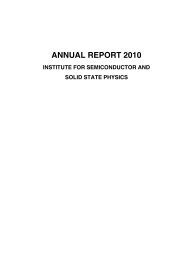Kinetic and Strain-Induced Self-Organization of SiGe ...
Kinetic and Strain-Induced Self-Organization of SiGe ...
Kinetic and Strain-Induced Self-Organization of SiGe ...
Create successful ePaper yourself
Turn your PDF publications into a flip-book with our unique Google optimized e-Paper software.
PREFACE iii<br />
Abstract<br />
A kinetic growth instability <strong>of</strong> silicon-germanium molecular beam epitaxy (<strong>SiGe</strong>-MBE) was<br />
used to generate periodic Si-ripple-templates. By increasing the substrate miscut to 4 ◦ the<br />
ripple period could be tuned to smaller periods towards the nanometer scale. At Si growth<br />
rates <strong>of</strong> 0.2 ˚A/s a ripple pattern with few defects develops within a small temperature window<br />
around 425 ◦ C. For our vicinal Si(001) substrates with 4 ◦ miscut along [110] this step-bunching<br />
instability provides undulations <strong>of</strong> about 100 nm periodicity <strong>and</strong> 4 nm amplitude.<br />
In the first part <strong>of</strong> this work several aspects <strong>of</strong> self-organized growth in the Si/<strong>SiGe</strong> system<br />
could be addressed. The special morphology <strong>of</strong> step-bunching was used to investigate the<br />
interplay between kinetics, surface energy <strong>and</strong> strain. The step-bunching templates provide<br />
a one-dimensional pattern with preferable nucleation sites for <strong>SiGe</strong>-isl<strong>and</strong>s along the ripple<br />
flanks, <strong>and</strong> thus allow us to combine kinetic <strong>and</strong> strain-driven self-organization phenomena<br />
in the Si/<strong>SiGe</strong> heterosystem. At moderate temperatures around 425 ◦ C strain-driven ridges,<br />
which decorate the ripple flanks perpendicular to the step bunches, were observed. The<br />
whole morphology is only made up with (001)-surfaces <strong>and</strong> {105}-facets. These {105}-faceted<br />
ridges appear to be energetically preferable for geometrical reasons at slopes, which are close<br />
to {1 1 10}-planes. These structures show a fair degree <strong>of</strong> ordering entirely based on self-<br />
organization. Furthermore, such morphological features are the basis for underst<strong>and</strong>ing the<br />
mechanism <strong>of</strong> Ge-dot nucleation on 2D pit-patterned Si-templates.<br />
In the second part magnetotransport measurements on p-modulation doped Si/<strong>SiGe</strong> het-<br />
erostructures grown on top <strong>of</strong> a step-bunched Si-buffer are discussed. The short-scale peri-<br />
odic height fluctuations <strong>of</strong> the Si-buffer form well-defined undulations in the <strong>SiGe</strong>-channel.<br />
This should increase scattering in the remotely p-doped quantum well (p-MODQW). Thus<br />
an asymmetry in mobility perpendicular <strong>and</strong> parallel to the undulations is expected, which<br />
might help to uncouple the different scattering mechanisms. These, namely alloy scattering<br />
<strong>and</strong> interface-roughness related scattering, are conversely discussed as predominant hole-<br />
mobility limiting factors for p-modulation doped structures. Although still at the beginning,<br />
the first measurements confirm a decreased low-temperature mobility across the undulations<br />
by a remarkable factor <strong>of</strong> two. Further measurements combined with additional modeling<br />
are expected to provide a new approach toward settling the long-lasting dispute on the hole-<br />
mobility-limiting scattering mechanisms in p-MODQW structures.











